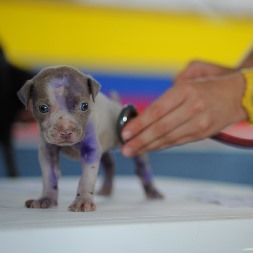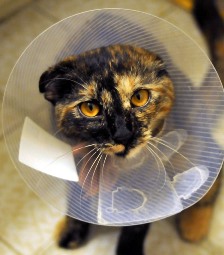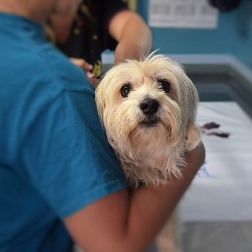How to Select a Veterinary Technician School near Northrop Minnesota
 Fulfilling your lifelong aspiration of working with and helping animals by enrolling in a vet tech school near Northrop MN may initially feel like a challenging undertaking. After all, you must locate and enroll in a school that will provide the appropriate training so that you can succeed as a veterinary technician. But just how do you approach assessing and contrasting colleges so that you can make the correct selection? Many future students launch their due diligence process by looking for colleges that are near their homes. Once they have located some area schools, they determine which ones have the cheapest tuition and hone in on those. Although cost and location are significant factors when comparing veterinary technician programs, they are not the only critical ones when making your comparisons. Qualifiers such as accreditation and internship programs should be evaluated also. The main idea is that there are questions you ought to be asking the vet tech schools you are looking at before you make an ultimate choice. We have presented several in this article in order to help get you started, but before we discuss them we’ll talk about the different duties of veterinary technicians and the training alternatives available.
Fulfilling your lifelong aspiration of working with and helping animals by enrolling in a vet tech school near Northrop MN may initially feel like a challenging undertaking. After all, you must locate and enroll in a school that will provide the appropriate training so that you can succeed as a veterinary technician. But just how do you approach assessing and contrasting colleges so that you can make the correct selection? Many future students launch their due diligence process by looking for colleges that are near their homes. Once they have located some area schools, they determine which ones have the cheapest tuition and hone in on those. Although cost and location are significant factors when comparing veterinary technician programs, they are not the only critical ones when making your comparisons. Qualifiers such as accreditation and internship programs should be evaluated also. The main idea is that there are questions you ought to be asking the vet tech schools you are looking at before you make an ultimate choice. We have presented several in this article in order to help get you started, but before we discuss them we’ll talk about the different duties of veterinary technicians and the training alternatives available.
The Role of a Vet Tech in Northrop MN
 Among the initial decisions that you will have to make is whether you want to train as a vet assistant, technologist or technician. Part of your decision may be dependent on the amount of time and money that you have to devote to your education, but the principal determiner will probably be which specialization interests you the most. What techs and assistants share in common is that they each work under the direct supervision of a licensed and practicing veterinarian. And even though there are many jobs that they can perform within the Northrop MN veterinary practice or hospital, they can’t prescribe drugs, diagnose ailments, or perform surgical procedures. In those areas they can only provide assistance to a licensed vet. There are technicians and technologists that work away from the standard veterinarian practice, for example for animal shelters, zoos or police departments. Let’s take a look at the responsibilities and education requirements for each position.
Among the initial decisions that you will have to make is whether you want to train as a vet assistant, technologist or technician. Part of your decision may be dependent on the amount of time and money that you have to devote to your education, but the principal determiner will probably be which specialization interests you the most. What techs and assistants share in common is that they each work under the direct supervision of a licensed and practicing veterinarian. And even though there are many jobs that they can perform within the Northrop MN veterinary practice or hospital, they can’t prescribe drugs, diagnose ailments, or perform surgical procedures. In those areas they can only provide assistance to a licensed vet. There are technicians and technologists that work away from the standard veterinarian practice, for example for animal shelters, zoos or police departments. Let’s take a look at the responsibilities and education requirements for each position.
- Vet Assistants in almost all cases will have gone through a structured training program, either as an apprentice or intern in a vet clinic or hospital, or by finishing a certificate program at a community college or trade school. As the name implies, their job function is to assist the veterinarians and vet techs in the performance of their duties. Normally they are not involved with more involved activities, such as assisting with surgical procedures. Some of their regular functions may include working at the front desk, cleaning and preparing exam rooms and equipment, or controlling pets during exams.
- Vet Technicians undergo more extensive training in contrast to assistants and normally obtain a two year Associate Degree, preferably from an American Veterinary Medical Association (AVMA) accredited program. They are in a sense the veterinary equivalent of medical nurses, since their general job function is to assist vets with diagnosing and treating animal patients. Where they vary from vet assistants is that they are included in more complicated duties, for example assisting with surgeries or administering medication. All states currently mandate that vet technicians pass a credentialing exam for either certification, registration or licensing.
- Vet Technologists are comparable to veterinary techs and for the most part perform the same job functions. They are required to obtain a Bachelor’s Degree in veterinary technology, which generally requires 4 years. Therefore the only real distinction between a vet technician and a technologist is the technologist’s higher level of education. But with an advanced degree comes more work options, higher salaries and possible management positions. They are additionally required to pass a credentialing examination for either certification, registration or licensing.
Vet technicians and technologists can specialize in areas such as internal medicine, anesthesia or emergency care. A number may obtain certification from the American Association for Laboratory Animal Science (AALAS) to work in Northrop MN labs or research facilities as well.
Online Vet Tech Schools Offered in Northrop
 An option that may be a solution for those with a busy schedule or who are working full time while attending veterinary college is to enroll in an online training program. Since the classes are made available through the internet, students can study on their own timetable wherever a computer is available. The course of study is taught using several venues, including videos, slide shows and live streaming webinars. And since many veterinary tech and technologist degrees require practical training, that part can typically be fulfilled as an internship or work study program at a local Northrop MN veterinarian clinic or hospital. Distance learning, as it is also called, may in some instances lower the cost of your education. Tuition and ancillary costs, for instance for traveling and study supplies, may be more affordable compared to more standard classroom programs. Just confirm that the program that you choose is accredited, either by the AVMA or another nationally recognized accrediting organization. With the online courses and the practical training, everything is included for a complete education. So if you are disciplined enough to learn in this more self-reliant mode, an online vet tech program may be the perfect choice for you.
An option that may be a solution for those with a busy schedule or who are working full time while attending veterinary college is to enroll in an online training program. Since the classes are made available through the internet, students can study on their own timetable wherever a computer is available. The course of study is taught using several venues, including videos, slide shows and live streaming webinars. And since many veterinary tech and technologist degrees require practical training, that part can typically be fulfilled as an internship or work study program at a local Northrop MN veterinarian clinic or hospital. Distance learning, as it is also called, may in some instances lower the cost of your education. Tuition and ancillary costs, for instance for traveling and study supplies, may be more affordable compared to more standard classroom programs. Just confirm that the program that you choose is accredited, either by the AVMA or another nationally recognized accrediting organization. With the online courses and the practical training, everything is included for a complete education. So if you are disciplined enough to learn in this more self-reliant mode, an online vet tech program may be the perfect choice for you.
What to Ask Northrop MN Vet Tech Schools
 At this point you should have selected which veterinarian credential that you wish to earn, and if you intend to study online or attend a college on campus. Since there are a large number of veterinarian community colleges, vocational and technical schools in the Northrop MN area and across the USA, you need to ask some relevant questions to help narrow down your list of alternatives. As we discussed in our opening, many prospective students start by prioritizing location and the cost of tuition. But we have previously mentioned other essential qualifiers, for example internship programs and accreditation. And of course you need to choose a college that offers the specialty and degree that you are interested in. These and other qualifications are covered in the checklist of questions that you need to ask the veterinary technician programs that you are reviewing.
At this point you should have selected which veterinarian credential that you wish to earn, and if you intend to study online or attend a college on campus. Since there are a large number of veterinarian community colleges, vocational and technical schools in the Northrop MN area and across the USA, you need to ask some relevant questions to help narrow down your list of alternatives. As we discussed in our opening, many prospective students start by prioritizing location and the cost of tuition. But we have previously mentioned other essential qualifiers, for example internship programs and accreditation. And of course you need to choose a college that offers the specialty and degree that you are interested in. These and other qualifications are covered in the checklist of questions that you need to ask the veterinary technician programs that you are reviewing.
Is the Veterinary School Accredited? It’s imperative that you verify that the veterinary technician college you enroll in is accredited by a regional or national accrediting organization. As earlier stated, among the most highly regarded is the American Veterinary Medical Association (AVMA). Trade schools and colleges that are accredited by the AVMA have undergone an extensive review process that verifies you will receive a superior education. Also, accreditation is essential if you are requesting a student loan or financial assistance, since many programs are not available for non-accredited programs. Last, having a certificate or degree from an accredited school is in many cases a prerequisite for employment for many Northrop MN area vet practices and hospitals.
What is the College’s Reputation? The vet vocational school or college and program you enroll in must have an outstanding reputation within the vet field. You can initiate your due diligence by asking the colleges you are looking at for references from the employers in their job assistance network. Other tips include looking on online school rating websites and speaking with the school’s accrediting organizations as well. You can ask the Minnesota school licensing department if there have been any complaints or violations regarding your targeted schools. As a final pointer, get in touch with some Northrop MN veterinarians that you may wish to work for after you get your training. Ask what they think of your school selections. They might even suggest some schools not on your list.
Are Internships Offered? The best way to get practical hands on training as a vet tech is to work in a medical setting. Find out if the schools you are considering have internship programs set up with Northrop MN veterinarians, vet hospitals or clinics. Almost all veterinary medicine programs require clinical training and many furnish it through internships. Not only will the experience be valuable regarding the practical training, but an internship can also help build relationships in the local veterinary community and aid in the search for a position after graduation.
Is Job Assistance Offered? Getting a job after graduating from a veterinary technician college can be challenging without the assistance of a job placement program. To begin with, ask what the graduation rates are for the colleges you are evaluating. A lower rate could mean that the teachers were ineffective at teaching the curriculum or that some students were dissatisfied with the program and quit. Next, verify that the schools have a job assistance program and ask what their placement rates are. A higher placement rate could mean that the school has an excellent reputation within the Northrop MN vet community and has a considerable network of contacts for student placements. A low rate could indicate that the training is not highly thought of by employers or that the job assistance program is a failure at placing students.
How Big are the Classes? If the classes are larger in size, you probably will get little or no individualized instruction from the teachers. Find out from the Northrop MN programs you are considering what their classroom teacher to student ratios are. You might also decide to participate in a couple of classes (if practical) to monitor the interaction between students and instructors. Ask for evaluations from students regarding the quality of instruction. Also, speak with the teachers and determine what their qualifications are as well as their approaches to teaching.
Where is the College Located? Okay, we already talked about location, but there are a few more points to consider on the topic. If you are going to drive to your vet tech classes from your Northrop MN home, you must make certain that the commuting time fits into your schedule. For instance, driving during the weekend to investigate the route won’t be the same as the drive during rush hour traffic, particularly if the school is located near or in a larger city. In addition, if you do choose to attend a school in another state or even outside of your County of residence, there may be higher tuition costs especially for state and community colleges. On the other hand, attending classes online may be an option that will give you more flexibility and reduce the necessity for travel.
Do the Classes Fit Your Schedule? And last, it’s important that you determine if the veterinarian colleges you are considering offer class times flexible enough to accommodate your schedule. For instance, many students continue to work full time and can only go to classes on the weekends or in the evenings near Northrop MN. Others may only be able to go to classes in the morning or in the afternoon. Make sure that the class times you need are offered before enrolling. Also, determine if you can make up classes that you may miss as a result of illness, work or family emergencies. You may find that an online school is the best solution to fit your veterinary training into your hectic life.
Enrolling in a Vet Tech School near Northrop MN?
If you have decided to attend a Veterinary Technician Program in the Northrop Minnesota area, then you may find the following information about the location of your school campus interesting and informing.
Northrop F-20 Tigershark
The Northrop F-20 Tigershark (initially F-5G) was a privately financed light fighter, designed and built by Northrop. Its development began in 1975 as a further evolution of Northrop's F-5E Tiger II, featuring a new engine that greatly improved overall performance, and a modern avionics suite including a powerful and flexible radar. Compared with the F-5E, the F-20 was much faster, gained beyond-visual-range air-to-air capability, and had a full suite of air-to-ground modes capable of firing most U.S. weapons. With these improved capabilities, the F-20 became competitive with contemporary fighter designs such as the General Dynamics F-16 Fighting Falcon, but was much less expensive to purchase and operate.
Much of the F-20's development was carried out under a US Department of Defense (DoD) project called "FX". FX sought to develop fighters that would be capable in combat with the latest Soviet aircraft, but excluding sensitive front-line technologies used by the United States Air Force's own aircraft. FX was a product of the Carter administration's military export policies, which aimed to provide foreign nations with high quality equipment without the risk of US front-line technology falling into Soviet hands. Northrop had high hopes for the F-20 in the international market, but policy changes following Ronald Reagan's election meant the F-20 had to compete for sales against aircraft like the F-16, the USAF's latest fighter design. The development program was abandoned in 1986 after three prototypes had been built and a fourth partially completed.[1]
When John F. Kennedy entered office in 1961, the U.S. Department of Defense was instructed to find an inexpensive fighter aircraft that the United States could offer to its allies through the Mutual Defense Assistance Act. A number of designs were studied, including stripped-down versions of the Lockheed F-104 Starfighter and Vought F-8 Crusader, and the newly designed Northrop N-156F. On 23 April 1962, the United States Air Force (USAF) informed the United States Secretary of Defense that the N-156F had been selected, under the designation F-5 and given the name "Freedom Fighter."[3] 847 F-5's of various early marks would be produced.[4]
Select the Right Veterinary Technician School near Northrop MN
 Selecting the right vet tech school is a critical first step to beginning a rewarding career providing treatment and care for pets and livestock. Potential students considering vet tech colleges must make their determination based on several key factors. Veterinary technicians and technologists are employed in animal hospitals, veterinary clinics and animal shelters. They commonly take on administrative responsibilities and support the veterinarian with the animal patients when needed. As we have covered, it’s very important that you enroll in a veterinary medicine program that is both accredited and has an outstanding reputation within the field. This goes for online vet tech schools as well. By asking the questions included in our checklist for assessing schools, you will be able to narrow down your alternatives so that you can make your final selection. And by picking the right college, you can reach your goal of becoming a veterinary technician in Northrop MN.
Selecting the right vet tech school is a critical first step to beginning a rewarding career providing treatment and care for pets and livestock. Potential students considering vet tech colleges must make their determination based on several key factors. Veterinary technicians and technologists are employed in animal hospitals, veterinary clinics and animal shelters. They commonly take on administrative responsibilities and support the veterinarian with the animal patients when needed. As we have covered, it’s very important that you enroll in a veterinary medicine program that is both accredited and has an outstanding reputation within the field. This goes for online vet tech schools as well. By asking the questions included in our checklist for assessing schools, you will be able to narrow down your alternatives so that you can make your final selection. And by picking the right college, you can reach your goal of becoming a veterinary technician in Northrop MN.
Other Doggone Good Cities in Minnesota

